Learning an instrument the like piano can be a challenging undertaking filled with exercises, symbols, and terms that might seem strange to a person who lacks a music background. The piano is an incredibly powerful and dynamic instrument that has much to offer musicians of every skill level and depth of experience. The piano is one of the most welcoming instruments to students with little to no music background. Instruments like the guitar or clarinet usually require weeks or even months of detailed practicing before a student can actually learn to play something, but a student with no piano experience can learn to play something almost immediately. Sadly, some people choose not to try learning this incredible instrument because of the difficult piano terminology.
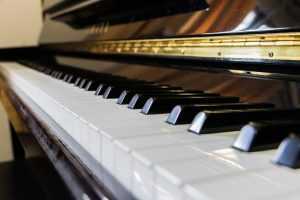
If you think most piano terminology seems foreign, then you’re right. Piano terms, which include dynamic performance markings, largely originated from the Italian language. According to the Italian translation website ALTA.com, “The 18th- and 19th- century heyday of opera and classical string and brass music took place, with notable exceptions, in Italy, and the terms currently used by classical musicians reflect the influence of the Italian language.” When you hear terms like Forte or Staccato, these words came from the Italian language. The piano itself is an instrument that was invented in Italy in 1700.
To help you understand the sometimes strange world of piano terminology, we’re going to walk you through some popular and lesser-known terms. These are nowhere near every term in music, but they’ll help you get started:
Dynamic Terms
PIANO
The word “piano” is now largely used to describe the instrument we all know and love, but it’s also still regularly used as a hugely important instruction in piano terminology. The word “piano” is an abbreviated version of the word “pianoforte,” an Italian term for the early 1700s version of the instrument. “Pianoforte” translates to “soft and loud” in Italian, and this term refers to the then newly-invented instrument’s uncanny ability to respond dynamically to a player’s touch. “Piano” is a dynamic command in which the musician is asked to play a passage of notes softly. The piano dynamic marking is perfect for passages of music that are more delicate and nuanced than others. To play a passage of notes in a piano style, try putting less weight than normal into each key when pressed. Piano dynamic markings are typically represented by a lowercase p that looks like this:

If the composer calls for a passage of notes to be played in an extremely quiet manner, a marking of two or even three lowercase p’s will be shown that look like something this:

FORTE
Forte notes are to be played loudly, and with force. The piano is one of the loudest and most powerful instruments on the planet, and most composers take advantage of this fact. To play notes in a forte style, add a controlled amount of weight and power to your approach. Similarly to piano dynamic markings, forte passages are represented by a single lowercase f that looks like this:

Notes that are to be played with extreme volume and force will be highlighted by two or even three lowercase f’s put together that look like this:

Forte sections have the ability to sound powerful and frightful or joyful and triumphant.
MEZZO
“Mezzo” translates to “half” or “moderately” in Italian. This dynamic marking is always paired with something else. For example, if you see something like this ![]() while playing piano, it means to play the passage of notes “Mezzo Forte” or moderately loud. The Mezzo dynamic marking helps to add nuance and control into a piece of music. Think of it as the brakes on a car. Playing anything with too much or not enough volume or power could ruin a piece of music. The Mezzo dynamic marking helps to inject thoughtful moderation into a musician’s performance.
while playing piano, it means to play the passage of notes “Mezzo Forte” or moderately loud. The Mezzo dynamic marking helps to add nuance and control into a piece of music. Think of it as the brakes on a car. Playing anything with too much or not enough volume or power could ruin a piece of music. The Mezzo dynamic marking helps to inject thoughtful moderation into a musician’s performance.
CRESCENDO
The term “Crescendo” has jumped off the music stand a found a wider use within the American vernacular, but for musical purposes, it simply refers to a section of music that gets gradually louder. This dynamic marking is ideal for building up excitement. It is notated like this:
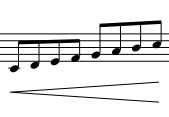
DECRESCENDO
A Decrescendo dynamic marking is used for when a composer wants the gradual quieting of a section. It is notated like this:
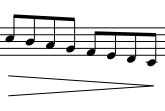
Articulation Piano Terminology
STACCATO
The word “staccato” translates to “short or detached” in Italian. When you see this term, the composer wants you to play the notes in a quick, detached manner that creates a sound that’s usually a vivid departure from the rest of the music. Think raindrops or quick, overly defined jabs of sound. Staccato notes have the ability to cut through the music in a powerful way. To play a staccato note, quickly press down a key and then immediately take your finger off it. There should be a distinct bounce in the movement of your finger here. You can play these notes quietly or loudly. Notes should be played staccato when you see a small dot over an individual note. It looks like this:
![]()
LEGATO
Legato notes are the opposite of staccato ones—long, connected and seamless. The Italian word “Legato” translates to “tied together” in piano terminology. When you see an instruction to play a passage of notes legato, it means that you’ll have to hold your fingers on the keys for a longer period of time. There should be no discernible break in the music when you play a series of notes on the piano in a Legato style. Legato interpretation and performance is ideal for conveying musical ideas that are lyrical, emotional and impactful. Legato can be notated with a curved line connecting the first and last notes of the passage to be played smoothly. It looks like this

Terms for Tempo
ACCELERANDO
This piano terminology instruction calls for musicians to gradually quicken the tempo over the marked passage. An Accelerando tempo marking is ideal for when a composer wants to inject excitement, drama, and change into a piece of music. Shifts in tempo, even gradual ones, have a way of making the listener lean in and pay attention. Rhythm is the part of music that’s most often intended to serve as stable, predictive material for our ears, and captivating results often occur when it becomes disrupted.
DECELERANDO
A Decelerando tempo marking calls for the gradual slowing of a section. Musical passages with this marking tend to settle into a new, altered mood.
RITARD
Decelerando tempo markings are used for the gradual slowing of a passage, but the Ritard (or Ritardando) tempo marking calls for an immediate slowing of a shortened passage of music. When a composer or songwriter wishes to emphasize a melody or bring a piece of music to a close, they often rely on this tempo marking.
GRAVE
This term indicates that the composer would like the music to be played in a very slow and serious manor. Solemn, contemplative and deeply emotional music usually is played with a Grave instructional marking.
ENERGICO
This dynamic marking means to play a piece of music with energy, enthusiasm, and zest. Energico is the opposite of grave.
RUBATO
This dynamic instruction was popularized in the Romantic era of music. A Rubato section of music is to be played without a strict tempo. During the Romantic era, emotion ruled over everything, and this piano terminology reflects that idea.
Terms for Form
CODA
A coda is a closing section of a movement. Codas typically are filled with resolutions and music that comes to a head. Think of what function the climax and resolution serves in the telling of a story. That’s what Codas are intended to sound like.
DA CAPO
In Italian, the term “Da Capo” translates to “from the head.” In sheet music, it serves as an instruction to repeat the beginning of the piece before stopping on the final chord. Composers and songwriters use terms like Da Capo to make music easier to read for musicians. Rather than writing out an entire section of music twice, terms like De Capo help provide straightforward and paper-saving instruction.
DC AL FINE
DC al Fine translates to “from the beginning to the end.” It’s an instruction to play through the piece of music until you reach the end which is sometimes marked by the word “fine.”

DC AL CODA
DC al Coda literally means “from the head to the tail”. It instructs the musician to go back and repeat the music from the beginning (“Capo”), and to continue playing until they reach the first coda symbol at which point they would jump to the coda to finish the piece.

DS AL CODA
D.S. al Coda instructs the musician to go back to a specific part of the piece marked by a special symbol and when Al coda is reached, jump to the coda symbol. It looks like this.
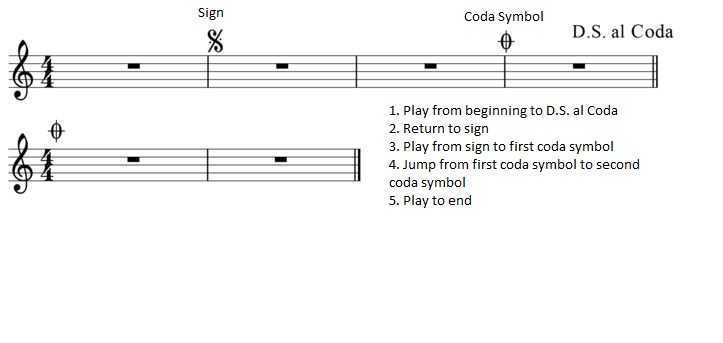
Other Piano Terminology
IMPROMPTU
This term refers to a short, intimate piece of music that’s often improvised. Composers and songwriters often sit down at the piano to create impromptu pieces that will later become songs or full musical works. Musicians usually gravitate toward improvising with some direction and guidelines rather than just beginning with a random selection of notes or chords. The 12 Bar Blues chord progression, for instance, is without a doubt the most well-known chord progression in music, and songwriters often play impromptu pieces in this style.
MOTIF
In music, a motif refers to a main musical theme that develops throughout the piece. Rossini’s Overture to William Tell features one of the most famous and recognizable motifs in all of music. Other notable examples include Bach’s Minuet in G, Beethoven’s Ode to Joy, and Wagner’s Ride of The Valkyries. A masterfully-crafted motif has the power to keep a listener engaged and interested throughout a long, complicated piece of music.
PENTATONIC SCALE
This is a piece of piano terminology that refers to a musical scale that has five notes. For example, the five black keys of a keyboard make up a pentatonic scale. These scales are most prominently featured in blues music as well as music from Asian countries. Pentatonic scales are easy scales for students of any age to learn.

REPRISE
This term calls for the musician to play a part of the piece that’s previously been played again. Reprised sections help to remind the listener of something (or someone in the case of when characters are assigned their own themes), and are ideal for giving a piece of music closure.
HOMOPHONY
Homophony is a term that describes when music is written to be sung or played in unison; when multiple musicians all play the exact same musical idea, that’s homophony. Homophony can be a powerful, jarring tool for songwriters and composers.
FERMATA
A fermata is a musical direction that calls for the musician to hold a tone or rest beyond its written value at the discretion of the performer. When a composer wants to highlight a moment or inject power and importance into a section of music, they’ll often use a fermata. One of the most famous fermatas in music is the one used in the “land of the free” section of the Star Spangled Banner.
![]()
FUGUE
A fugue is a composition written for three to six voices. Starting from the beginning of the piece, each voice enters at different times. These staggered entrances create counterpoint with one another. Fugues are usually found in older pieces of music.
DECEPTIVE CADENCE
A deceptive cadence occurs when a chord progression seems to be coming to an end but doesn’t. In major keys, a deceptive cadence often happens when a minor 6th chord is played rather than a dominant 5th chord. This is a tool for composers and songwriters to play with listener expectations, and it helps them to extend and develop their musical ideas.
ETUDE
This piano terminology term refers to a piece of music written with the exclusive purpose of improving a musician’s technique. An etude is not quite a musical exercise and not quite a stand-alone piece of music. Etudes are powerful tools that can help improve your muscle memory, rhythm, and overall prowess on the piano.
INTERVAL
An interval is defined as the distance between two notes. In music theory, chords are built off of playing notes of varying intervals at the same time. In the context of melodies, intervals are often taught by learning to detect them within popular music. For instance, a P5 (an interval known as the perfect 5th) can be heard in the first two notes of the Star Wars theme written by John Williams. The terrifying music in the movie Jaws (also written by Williams), is built off of the minor 2nd interval. The first two notes of the song for the opening credits of The Simpsons features a Tritone interval.
ATONAL
Atonal is a term that describes music that’s written without regard to any specific key. Many modern pieces of music are considered to be atonal, and they’re often written by using complex math equations. Atonal music can be jarring and even off-putting for listeners who are used to conventional works of music.
POLYPHONY
This term refers to the combination of a number of individual but harmonizing melodies. Polyrhythm is the same idea but with rhythms instead of harmonies. Lots of incredible rich and interesting music features polyphony and polyrhythm.
OSTINATO
An ostinato is a repeated phrase. Ostinatos can be found in classical music as well as modern music. The composer Philip Glass builds his compelling style of music off of ostinatos that subtly swell and transform into different shapes and musical ideas. Modern electronic music heavily relies on the use of ostinatos.
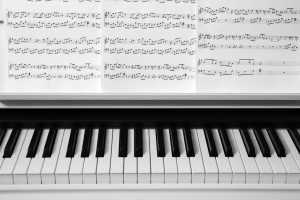
Piano terminology seems complex at first, but students will find these terms and ideas easier to understand with time. It’s easy to forget, but songwriters and composers want nothing more than their music to be easily read and understood by musicians. If you come across a musical term you don’t understand, simply search for the term’s meaning on your computer.

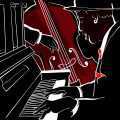
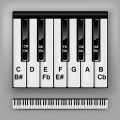
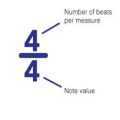
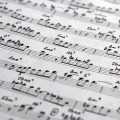
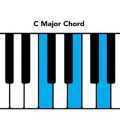

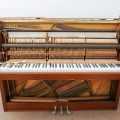
1 thought on “Piano Terminology: Top Terms to Know for Beginning Pianists”